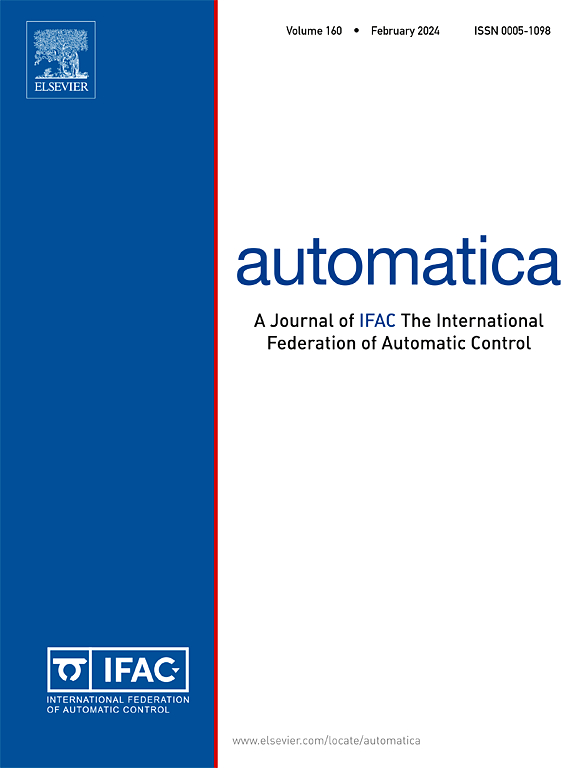符号不定先验的数据同化:Sinkhorn算法的推广
IF 5.9
2区 计算机科学
Q1 AUTOMATION & CONTROL SYSTEMS
引用次数: 0
摘要
我们处理一个迄今为止尚未研究的问题,这个问题的动机是需要对关系的促进/抑制贡献进行建模,如在基因调控网络中,以解释观察到的经验分布。没有已知的预先存在的工作集中在这个问题上,本质上,包括校准一个符号不确定的数据集,表示关于促进/抑制联合强度的先验信息,以恢复与指定观察到的边际的一致性。我们在n个对象之间的关系的一般设置中解决问题,然后专门研究二进制关系,以便与遵循Metropolis-Hastings原理的可能的临时替代方案进行比较。因此,我们的论文从解决一般问题开始,找到一个多维数组(代表n个因素的相对贡献)来匹配指定的边际;突出的特征是条目的符号(促进/抑制)应该与先前的符号相匹配。我们开发了一种方法,是基于最小化一个合适的熵函数服从约束。我们的方法逐字逐句地遵循Schrödinger的基本原理(Schrödinger, 1931, 1932),这是统计学中著名的Sinkhorn-Knopp算法的基础,该算法用于调和列联表(正/频率数据集)与边际数据(Knight, 2008)。对于我们的符号不定先验情况的结果算法推广了Sinkhorn-Knopp算法,因为它相当于沿着不同坐标方向迭代缩放数组的条目。缩放是乘法的,但与Sinkhorn-Knopp相反,根据条目的符号,缩放是逆乘法的。当先验的条目非负时,我们的算法简化为经典的Sinkhorn-Knopp算法,近年来,该算法已成为最优运输的计算工具(peyr本文章由计算机程序翻译,如有差异,请以英文原文为准。
Data Assimilation for Sign-indefinite Priors: A generalization of Sinkhorn’s algorithm
We deal with a hitherto unstudied problem that is motivated by the need to model promotion/inhibition contributions of relations, as in gene regulatory networks, to explain observed empirical distributions. There is no known pre-existing work focusing on this problem which, in essence, consists in calibrating a sign-indefinite data set representing prior information on the joint strength of promotion/inhibition, to restore consistency with specified observed marginals. We address the problem in the general setting of relations between objects, and then specialize to binary relations to compare with a possible adhoc alternative following a Metropolis–Hastings rationale. Thus, our paper begins by addressing the general problem to find a multi-dimensional array (representing relative contribution of the factors) to match specified marginals; the salient feature is that the sign (promotion/inhibition) of entries should match that of the prior. We develop an approach that is based on minimizing a suitable entropy functional subject to the constraints. Our approach follows verbatim Schrödinger’s rationale (Schrödinger, 1931, 1932) that underlies the celebrated Sinkhorn–Knopp algorithm in statistics used to reconcile contingency tables (of positive/frequency data sets) with marginal data (Knight, 2008). The resulting algorithm for our case of sign-indefinite prior generalizes the Sinkhorn–Knopp algorithm in that it amounts to iterative scaling of the entries of the array along different coordinate directions. The scaling is multiplicative but also, in contrast to Sinkhorn–Knopp, inverse-multiplicative depending on the sign of entries. When the entries of the prior are non-negative, our algorithm reduces to the classical Sinkhorn–Knopp algorithm which, in recent years, has become the computational workhorse of optimal transport (Peyré and Cuturi, 2019). Interestingly, the extension of the Sinkhorn–Knopp algorithm herein is perhaps the only example of a coordinate gradient ascent algorithm, other than the classical Sinkhorn, that has a non-trivial closed-form solution.
求助全文
通过发布文献求助,成功后即可免费获取论文全文。
去求助
来源期刊

Automatica
工程技术-工程:电子与电气
CiteScore
10.70
自引率
7.80%
发文量
617
审稿时长
5 months
期刊介绍:
Automatica is a leading archival publication in the field of systems and control. The field encompasses today a broad set of areas and topics, and is thriving not only within itself but also in terms of its impact on other fields, such as communications, computers, biology, energy and economics. Since its inception in 1963, Automatica has kept abreast with the evolution of the field over the years, and has emerged as a leading publication driving the trends in the field.
After being founded in 1963, Automatica became a journal of the International Federation of Automatic Control (IFAC) in 1969. It features a characteristic blend of theoretical and applied papers of archival, lasting value, reporting cutting edge research results by authors across the globe. It features articles in distinct categories, including regular, brief and survey papers, technical communiqués, correspondence items, as well as reviews on published books of interest to the readership. It occasionally publishes special issues on emerging new topics or established mature topics of interest to a broad audience.
Automatica solicits original high-quality contributions in all the categories listed above, and in all areas of systems and control interpreted in a broad sense and evolving constantly. They may be submitted directly to a subject editor or to the Editor-in-Chief if not sure about the subject area. Editorial procedures in place assure careful, fair, and prompt handling of all submitted articles. Accepted papers appear in the journal in the shortest time feasible given production time constraints.
 求助内容:
求助内容: 应助结果提醒方式:
应助结果提醒方式:


